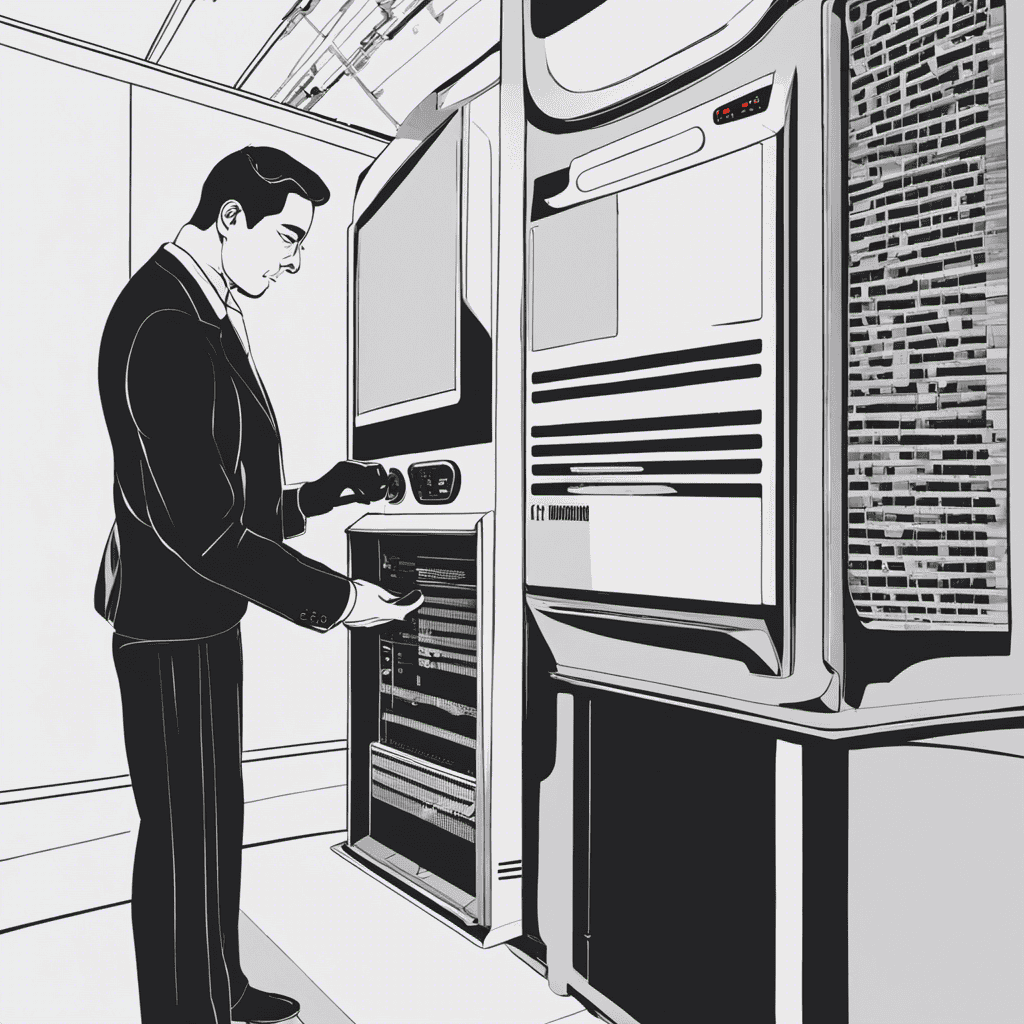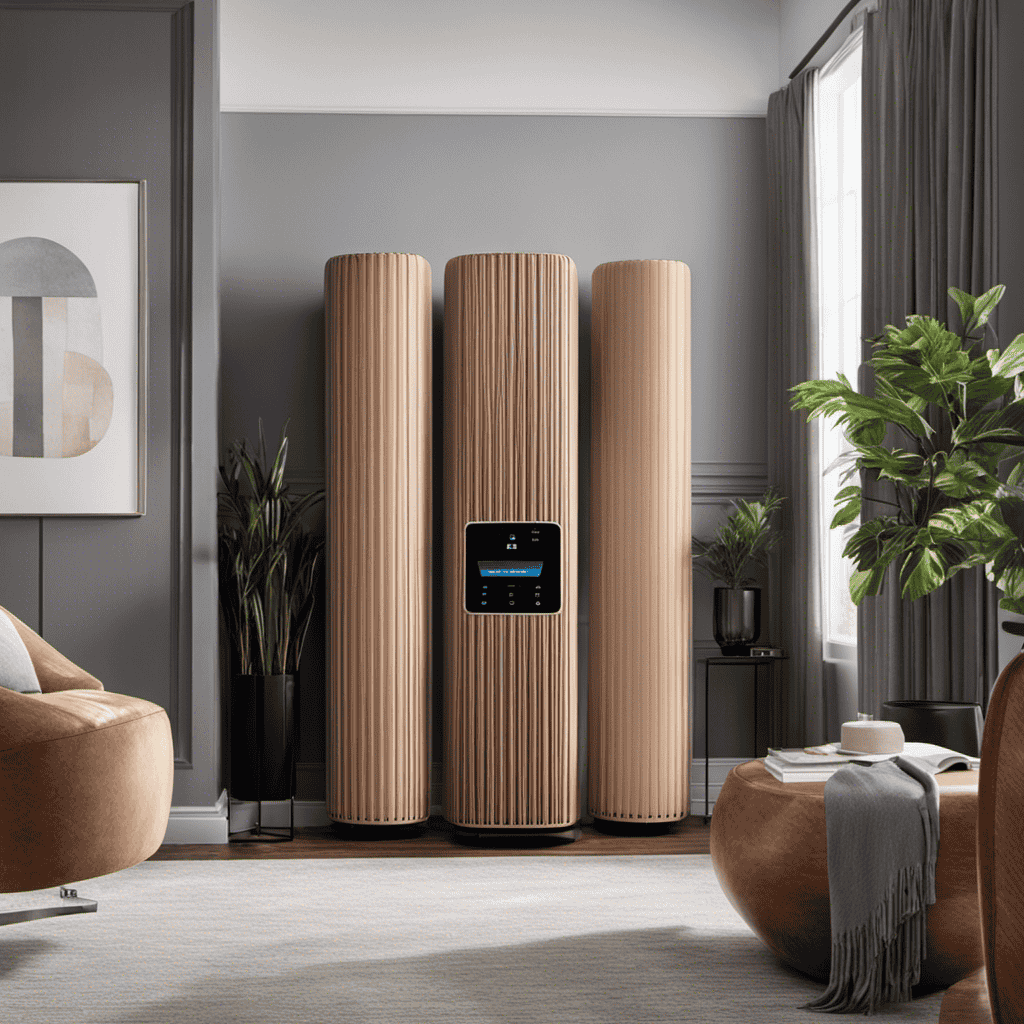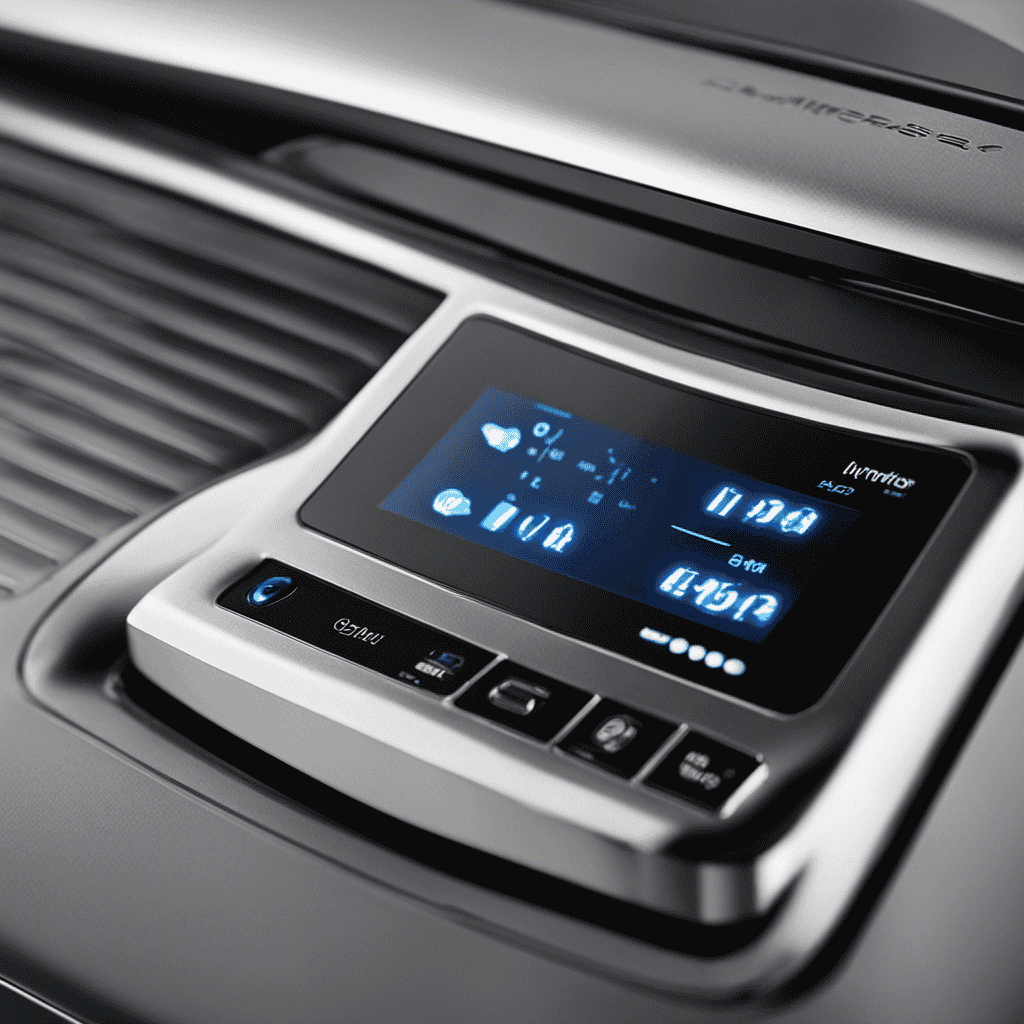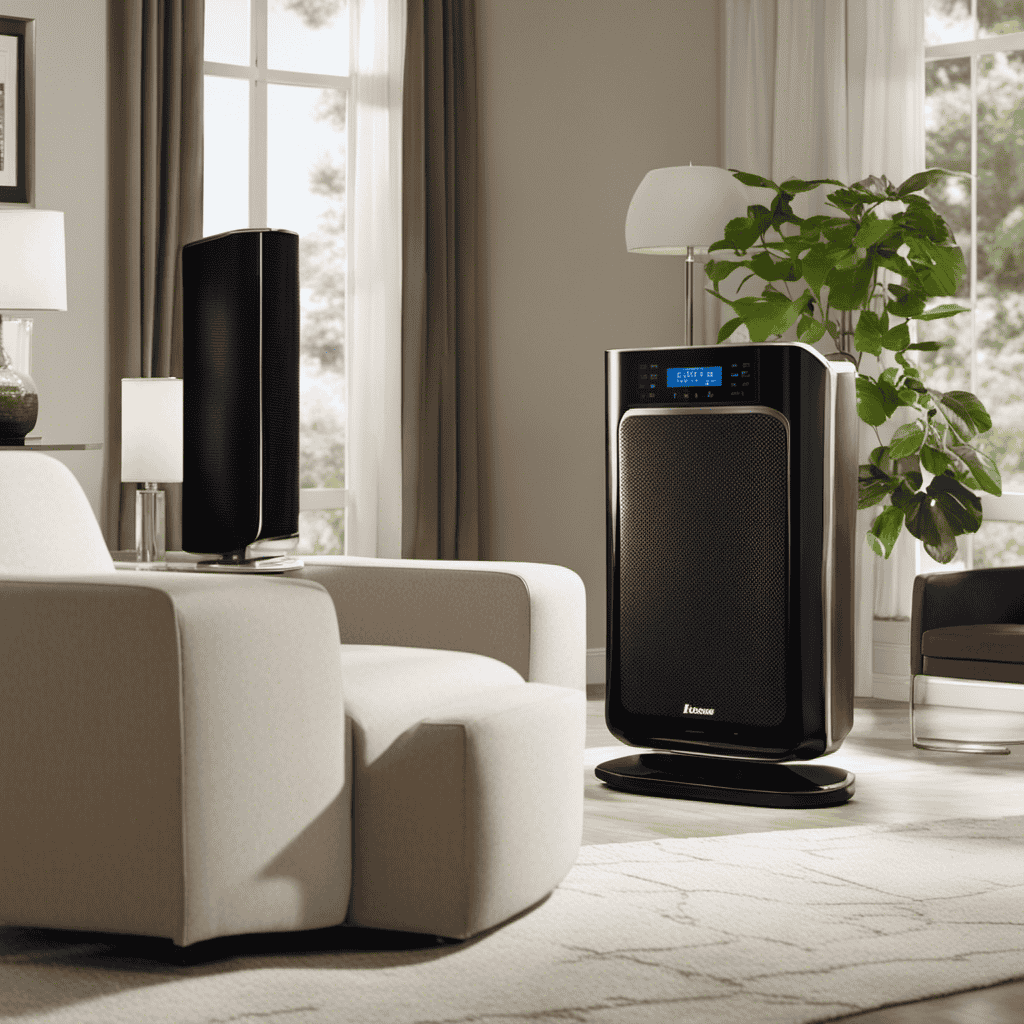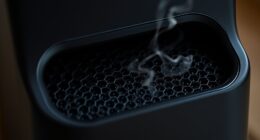I believed air purifiers would simplify things, but I was mistaken! With numerous buttons, modes, and indicators, understanding how to operate an air purifier can seem like decoding a secret message.
But fear not, because in this article, I’ll guide you through the labyrinth of air purifier displays, modes, filters, and more. Get ready to unleash your inner detective as we unravel the mysteries of air purification technology.
Let’s dive in!
Key Takeaways
- Familiarize yourself with different icons and indicators on the air purifier display, such as numerical values for air quality index (AQI) and icons representing pollutants like dust, pollen, or smoke.
- Understand the different modes and settings of the air purifier, such as sleep mode or turbo mode, and customize them to optimize the air purification process, considering filtration efficiency, noise level, and energy consumption.
- Regularly clean and replace filters according to manufacturer’s instructions to ensure effective operation, and keep the air purifier in a clean and dust-free environment suitable for the size of the room or area.
- Customize fan speed and purification modes based on preference and air pollution level, maximize efficiency by adjusting settings to meet needs, and monitor filter lifespan and maintenance alerts to ensure clean and healthy air.
Understanding the Air Purifier Display
To understand the air purifier display, you’ll need to familiarize yourself with the different icons and indicators.
Decoding air quality and interpreting sensor data is crucial in determining the effectiveness of your air purifier. The display typically includes a numerical value representing the air quality index (AQI). This index ranges from good to poor, providing a quick snapshot of the current air quality.
Additionally, the display may feature icons indicating the presence of pollutants such as dust, pollen, or smoke. These icons help you identify the specific contaminants in your environment.
The sensor data provides real-time information on particle levels, allowing you to monitor changes and adjust settings accordingly.
Decoding Air Purifier Modes and Settings
When it comes to air purifiers, it’s important to understand the different modes they offer.
By knowing the various modes, such as sleep mode or turbo mode, you can optimize the air purification process based on your specific needs.
Additionally, customizing the settings of your air purifier can greatly enhance its efficiency and effectiveness in removing pollutants from the air.
Understanding Different Modes
Understanding the different modes is important because it allows you to customize the air purifier’s settings to fit your specific needs. When comparing different air purification technologies, it’s essential to evaluate the effectiveness of different air purifier modes. Here are three key factors to consider:
-
Filtration Efficiency: Different modes may use various filtration technologies such as HEPA filters, activated carbon filters, or UV-C light. Understanding how these technologies work and their efficiency in capturing pollutants can help you choose the right mode for your air purifier.
-
Noise Level: Some modes may operate at a higher fan speed, resulting in increased noise. Evaluating the noise level of different modes can help you select a mode that balances purification performance and noise output.
-
Energy Consumption: Different modes may consume varying amounts of energy. Considering the energy consumption of each mode can help you make an informed decision, especially if you are concerned about energy efficiency.
Optimizing Air Purification
By considering the three key factors, you can make an informed decision and maximize your air purification.
When it comes to improving air quality at home, proper air purifier maintenance is essential. Regularly cleaning and replacing the filters is crucial to ensure optimal performance. Filters should be cleaned or replaced according to the manufacturer’s instructions, usually every three to six months.
Additionally, it is important to keep the air purifier in a clean and dust-free environment. Dust and debris can accumulate on the unit and hinder its efficiency.
Lastly, consider the size and coverage area of the air purifier. Ensure that it is suitable for the size of the room or area you want to purify.
Following these air purifier maintenance tips will help you maintain clean and healthy air in your home.
Customizing Settings for Efficiency
To maximize efficiency, adjust the settings on your air purifier to meet your specific needs. Customizing the fan speed and adjusting purification modes can greatly enhance the performance of your air purifier. Here are a few tips to help you optimize your settings:
-
Customizing fan speed: Some air purifiers have multiple fan speed options. Higher fan speeds can provide faster air circulation and better purification, but they may also generate more noise. Adjust the fan speed based on your preference and the level of air pollution in your environment.
-
Adjusting purification modes: Many air purifiers offer different purification modes, such as general, allergy, and night mode. Each mode is designed to address specific air quality concerns. For example, the allergy mode may have a higher filtration rate to capture allergens. Choose the mode that suits your needs and the current air quality conditions.
Interpreting Air Quality Indicators
The air purifier’s indicator light shows whether the air quality is good or bad. It provides a convenient way to assess the air pollution levels in your environment. The indicator light is typically color-coded, with green indicating good air quality and red indicating poor air quality. However, it is important to note that different air purifiers may use different color schemes or symbols to represent air quality. To help you better understand the air quality indicators, refer to the table below:
| Air Quality Indicator | Air Quality Level |
|---|---|
| Green | Good |
| Yellow | Moderate |
| Orange | Unhealthy |
| Red | Very Unhealthy |
Reading Filter Replacement Alerts
Understanding filter lifespan, alert indicator colors, and replacing filters correctly are crucial aspects of maintaining optimal performance in an air purifier.
By understanding the lifespan of filters, users can plan ahead and ensure timely replacements to maintain clean and healthy indoor air.
Alert indicator colors serve as visual cues, providing valuable information about the condition of the filters and prompting users to take action when necessary.
Lastly, correctly replacing filters is essential to ensure proper filtration and prevent any potential damage to the air purifier.
Understanding Filter Lifespan
You should check the filter lifespan on your air purifier regularly to ensure it’s working effectively. Proper filter maintenance is essential to keep your air purifier running efficiently and to extend the filter lifespan.
Here are some tips to help you maintain your air purifier filters:
-
Clean or replace pre-filters regularly: Pre-filters catch larger particles and protect the main filter. Cleaning or replacing them regularly prevents clogging and improves overall performance.
-
Vacuum or wash reusable filters: Some filters are washable or vacuum-friendly. Regularly cleaning them removes trapped particles and ensures optimal airflow.
-
Follow manufacturer’s recommendations: Check the user manual or manufacturer’s website for specific instructions on how often to replace or clean filters. They will provide guidance based on the type of filter and usage.
Alert Indicator Colors
In order to ensure that your air purifier is working effectively, it is crucial to understand the alert indicator colors. These colors indicate the current condition of the air quality and the maintenance level of the filters. Different manufacturers may use slightly different color schemes, but generally, the alert indicator follows a green, yellow, and red system.
To illustrate this, here is a table showcasing the alert indicator colors and their corresponding meanings:
| Alert Indicator Color | Air Quality | Filter Maintenance |
|---|---|---|
| Green | Good | Filters clean |
| Yellow | Fair | Filters nearing replacement |
| Red | Poor | Filters need immediate replacement |
By regularly checking the alert indicator, you can stay aware of the air quality standards in your environment and ensure proper filter maintenance. This will help to maintain optimal air purification and improve the overall air quality in your space.
Now that we understand the alert indicator colors, let’s move on to the next section: replacing filters correctly.
Replacing Filters Correctly
To ensure proper filter maintenance, it’s important to know the correct way to replace filters. Here are the steps to replace filters correctly:
- Turn off the air purifier and unplug it from the power source.
- Locate the filter compartment and open it according to the manufacturer’s instructions.
- Remove the old filter carefully, making sure not to damage it or release any accumulated dust or particles.
- Insert the new filter into the compartment, ensuring it is properly aligned.
- Close the filter compartment securely.
- Plug the air purifier back in and turn it on.
Regularly check and clean the filters to ensure optimal performance and extended lifespan.
Analyzing Fan Speed Options
The air purifier has multiple fan speed options to choose from. This feature allows me to control the speed at which the air is circulated in the room. By adjusting the fan speed, I can customize the air purifier’s performance based on my needs and preferences. To better understand the different fan speed options, I have created a table below that outlines the various levels and their corresponding air circulation patterns.
| Fan Speed | Air Circulation Pattern |
|---|---|
| Low | Gentle and quiet |
| Medium | Balanced airflow |
| High | Powerful and fast |
| Turbo | Maximum airflow |
| Auto | Automatically adjusts |
Having these options gives me the flexibility to choose the appropriate fan speed for different situations, such as when I want a quiet and gentle airflow for sleeping or a powerful and fast airflow for quickly cleaning the air in a larger space. It’s reassuring to know that the air purifier is equipped with fan speed control, allowing me to optimize its performance to suit my needs.
Navigating Timer and Schedule Functions
When it comes to using an air purifier, understanding how to navigate the timer and schedule functions is crucial.
Setting timer preferences allows you to control when the air purifier turns on and off, ensuring that it operates only when needed.
Optimizing schedule settings allows you to customize the air purifier’s operation throughout the day, aligning it with your specific needs and lifestyle.
Understanding the various function options available ensures that you can make the most out of your air purifier, maximizing its effectiveness in improving indoor air quality.
Setting Timer Preferences
Adjust the timer preferences on your air purifier to automatically turn it on and off at specific times. This feature allows you to customize the fan speed and duration according to your needs. By setting the preferences, you can ensure that your air purifier operates efficiently and effectively. Here’s how you can do it:
- Access the timer settings on your air purifier’s control panel.
- Select the desired time to turn the air purifier on and off.
- Adjust the fan speed and duration based on your preferences.
Customizing the fan speed and setting preferences for your air purifier not only improves the air quality in your space but also helps conserve energy. It allows you to have control over the functioning of the device, ensuring that it operates at the most suitable times for you.
Take advantage of this feature to optimize the performance of your air purifier and enjoy cleaner and fresher air.
Optimizing Schedule Settings
To optimize your schedule settings, you can easily customize the timer preferences on your air purifier. By adjusting the timer settings, you can ensure that your air purifier operates at the most efficient times, maximizing its effectiveness while reducing energy consumption. Scheduling optimization is crucial in achieving a healthy and clean indoor environment while minimizing energy costs. To help you understand the importance of scheduling optimization, consider the following table:
| Time Slot | Functionality |
|---|---|
| 8 AM – 10 AM | High-speed purification |
| 10 AM – 2 PM | Low-speed purification |
| 2 PM – 4 PM | Standby mode, conserving energy |
| 4 PM – 8 PM | High-speed purification |
| 8 PM – 8 AM | Sleep mode, quiet operation |
Understanding Function Options
Make sure you understand the different function options available on your air purifier so that you can effectively optimize its performance. Here are some key features to consider:
-
Customizing airflow: Many air purifiers offer adjustable fan speeds or modes that allow you to control the airflow. This is particularly useful if you want to increase the circulation in a larger room or reduce it in a smaller space.
-
Adjusting purification levels: Some air purifiers have multiple purification levels, such as low, medium, and high. These levels determine the intensity at which the air is purified. Adjusting the purification level can help you target specific air quality issues or conserve energy when the air quality is already good.
-
Timer settings: Certain air purifiers come with timer options that allow you to schedule when the device operates. This can be helpful if you want the purifier to run only during certain times of the day or night, saving energy and ensuring optimal performance.
Understanding these function options will enable you to customize your air purifier to suit your specific needs. By customizing airflow and adjusting purification levels, you can ensure that your air purifier is working efficiently to provide you with clean and fresh air.
In addition to understanding the function options of your air purifier, it’s also important to monitor its power consumption information to ensure that it is operating efficiently and effectively.
Monitoring Power Consumption Information
Take a look at the display screen to see the power consumption information of your air purifier. Power consumption tracking is an essential feature that allows you to monitor the energy usage of your device.
By understanding how much power your air purifier is consuming, you can make informed decisions to optimize its energy efficiency. To reduce power consumption and save energy, consider implementing these energy-saving tips.
First, adjust the fan speed to a lower setting, as higher speeds tend to consume more power. Second, utilize the timer function to schedule the air purifier to run only when needed. Lastly, keep the air purifier clean and maintain proper filter replacement to ensure its optimal performance.
Interpreting Error Codes and Troubleshooting Tips
When encountering error codes on the display screen, refer to the user manual for troubleshooting tips. Understanding the meanings behind these error codes is crucial for effectively troubleshooting common issues with your air purifier.
Here are some key steps to follow:
-
Check the error code in the user manual: The user manual will provide a comprehensive list of error codes and their corresponding meanings.
-
Identify the cause of the error: Once you have the error code, try to identify the specific issue that is causing it. This could be related to a clogged filter, a malfunctioning sensor, or a power supply problem.
-
Take appropriate action: Once you have identified the cause, follow the troubleshooting tips provided in the user manual to resolve the issue. This may involve cleaning or replacing filters, resetting the device, or seeking professional assistance if necessary.
Understanding Noise Levels and Sleep Mode
Understanding the noise levels and how sleep mode works can help you create a peaceful environment for a good night’s rest. Noise reduction techniques are essential for ensuring a quiet and relaxing sleep environment.
Air purifiers often come with different fan speed settings, which can generate varying levels of noise. By understanding these noise levels, you can choose a setting that suits your preferences and promotes better sleep.
Additionally, many air purifiers have a sleep mode feature that operates at a lower fan speed, resulting in quieter operation. Sleep mode not only reduces noise but also saves energy and prolongs the lifespan of the purifier.
It’s important to note that while sleep mode may reduce noise, it may also reduce the purifier’s effectiveness in cleaning the air. Therefore, it’s crucial to strike a balance between noise reduction and air purification when using sleep mode.
Reading Maintenance and Cleaning Instructions
To keep your device in optimal condition, make sure to regularly clean and maintain it according to the provided instructions. Neglecting maintenance can lead to decreased performance and potential damage to the air purifier.
Here are some important cleaning techniques and a suggested maintenance schedule to follow:
-
Dusting: Use a soft, dry cloth or a vacuum cleaner with a brush attachment to remove dust from the exterior surface and vents of the air purifier.
-
Filter Cleaning: Follow the manufacturer’s instructions on how to clean or replace the filters. Some filters may need to be washed or vacuumed, while others may need to be replaced periodically.
-
Sensor Cleaning: If your air purifier has sensors, clean them gently with a soft cloth to ensure accurate readings.
Maintenance Schedule:
-
Weekly: Dust the exterior and vents.
-
Monthly: Clean or replace the filters.
-
As needed: Clean the sensors.
Following these cleaning techniques and maintenance schedule will help ensure that your air purifier continues to provide clean and fresh air efficiently.
Frequently Asked Questions
How Does an Air Purifier Work to Improve Indoor Air Quality?
An air purifier works by using filter technology to remove pollutants and allergens from the air, improving indoor air quality. It is beneficial to use an air purifier in a home or office environment to create a healthier breathing environment.
Are There Any Potential Health Risks Associated With Using an Air Purifier?
There may be potential side effects associated with using an air purifier, such as dryness or irritation of the eyes and throat. However, long-term effects are not well-documented and further research is needed to fully understand the health risks.
Can an Air Purifier Help With Specific Allergies or Respiratory Conditions?
An air purifier can be effective in reducing allergens and improving air quality for those with allergies or respiratory conditions. The best air purifiers have HEPA filters and can capture even the smallest particles.
How Often Should I Replace the Air Filters in My Air Purifier?
I replace my air filters regularly to ensure my air purifier functions effectively. To choose the right filter, I consider my specific needs and where to buy replacements for my air purifier.
Are There Any Specific Safety Precautions I Should Take When Using an Air Purifier?
When using an air purifier, it is important to take specific safety precautions to minimize potential health risks. This includes ensuring proper ventilation, keeping the device away from flammable materials, and regularly cleaning and replacing filters.
What Features Should I Look for When Reading Air Purifier Reviews?
When choosing the right air purifier, it’s important to look for features like the CADR (Clean Air Delivery Rate) number, room size coverage, and filter type. Air purifier reviews can give insight into performance, noise level, and additional features like air quality sensors and smart capabilities. Consider these factors carefully.
Conclusion
In conclusion, understanding how to read an air purifier is essential for optimizing its performance and ensuring clean and healthy indoor air. By decoding the display, interpreting air quality indicators, and analyzing various settings, users can effectively monitor and maintain their air purifier.
One interesting statistic to consider is that indoor air can be up to five times more polluted than outdoor air, highlighting the importance of investing in an air purifier to protect our health and well-being.
So, let’s take control of our indoor air quality and breathe easy!
